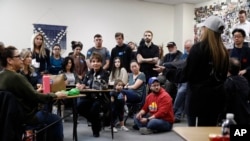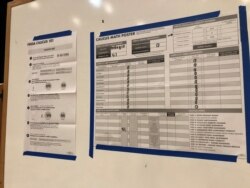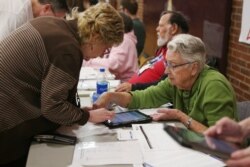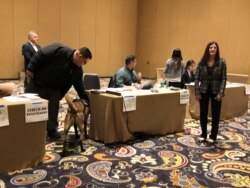Nevada Democratic caucus organizers were under a microscope Saturday while Democratic presidential candidates and their supporters anxiously awaited the results of the voting.
There was no doubt that Vermont Senator Bernie Sanders was headed for a crushing victory over his half-dozen rivals, including former Vice President Joe Biden, former Mayor Pete Buttigieg of South Bend, Indiana, and Senator Elizabeth Warren of Massachusetts.
But the votes trickled out during late afternoon and early evening. State Democratic Party officials struggled to avert the vote-counting fiasco that embarrassed state and national party officials in Iowa in early February, when they employed a vote-counting app that was wrongly coded and produced unreliable results from voting precincts.
Stunned by that development, Nevada officials retreated from a vote count that relied heavily on the same new technology utilized by Iowans, switching to the use of a simpler system involving Apple iPads and Google spreadsheets to compute the votes and award delegates to candidates.
But some of the precinct captains had trouble phoning in the results to a party hotline, with some complaining about getting a busy signal or being put on hold for an hour or longer.
'Worked perfectly'
“The app worked perfectly,” Phil Subutka, a caucus leader for a precinct at Coronado High School in Henderson, Nevada, told The Washington Post, as he repeatedly hit redial to the party’s hotline. “But we can’t get through on the phone.”
Moreover, some precinct officials were confused about how to combine early votes cast by Democrats with the votes cast by caucusgoers who showed up Saturday afternoon.
Party officials said nearly 75,000 people voted during four days of early balloting, February 15-18, with few problems, although there were long lines of voters at some polling places. The bulk of the voting, however, occurred Saturday. More than 3,000 volunteers were set to work at more than 250 voting sites after receiving extensive training on how to tabulate votes.
The caucuses formally began at 3 p.m. EST (2000 UTC) and lasted two to three hours. Official vote returns didn’t start rolling in until shortly before 7 p.m. EST.
Gathering and reporting votes at caucuses is confusing and challenging, even under the best of circumstances. Instead of voters simply showing up and casting ballots for their preferred candidates, which is the way it is done in primary elections, caucusgoers must invest several hours, taking part in an elaborate process.
The goal for caucusgoers is to help their preferred candidate achieve “viability” and win delegates. If their candidate can't meet a 15% threshold of support, they can join forces with other voters to back another candidate. Or simply give up and go home.
At the Bellagio
One such drama played out Saturday at the posh Bellagio Hotel on the Las Vegas Strip. Corliss Gaines, wearing her maid uniform and name tag, arrived at her precinct there, ready to put her support behind billionaire businessman Tom Steyer because, she said, “He strikes me as presidential.”
Gaines said she had to “listen intensely” to understand the process because it was her first caucus.
An hour later, after all the voters stood at various spots in the room for their candidates, Gaines realized Steyer would not be viable because he couldn’t meet the support threshold. So during a second round of voting, or “realignment,” she threw her support behind Biden and said she felt comfortable with her decision.
“Biden is the right choice. Sanders, ugh,” she said, as she turned her thumb downward.
Kimberly Carr, a greeter at the Bellagio, was smitten by Warren after the senator’s strong performance at Wednesday night’s candidates debate.
“I thought she was super strong,” Carr said, “and I like her plans for everything.”
But when Carr stood at the front of the Bellagio ballroom in support of her candidate, she realized only four other voters had joined her. She considered staying there to reinforce her drive to elect a female president, but reality persuaded her to do otherwise, and she switched her vote to Sanders.
Voter Paul Anthony left the ballroom disgusted. He was a Buttigieg supporter. When the former mayor did not receive a single vote and there was no one from the campaign to try to persuade anyone to switch, Anthony shifted his vote to Steyer. But then Steyer was deemed unviable and Anthony walked out.
Anthony complained that the two remaining choices – Biden and Sanders – “represent what is broken in Washington” and do not offer anything new.
































